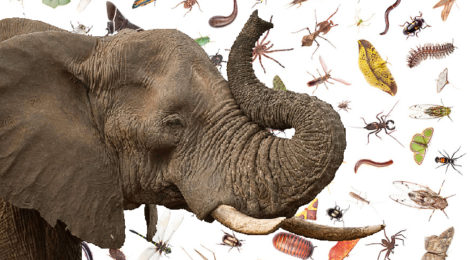
About Ignoring The Elephants and The Insects … Don’t!
All over the world insects are reported to be disappearing.
They aren’t gone completely anywhere yet, but their numbers reveal far more than decimation, 75% of our insect shipmates are missing in Europe.
What about the ontogeny and phylogeny of insects might teach us about the source of their peril?
Hint, it is all about yesterday’s CO2, but the ‘global warming’ effect of that CO2 is far from the problem.
The problem is insect ontogeny, their individual nature and ability to adapt, it is being overwhelmed by the trillion tonnes of yesterday’s CO2, our fossil fuel/fool age emissions from 100 years of our yesterdays. The insects’ phylogeny, their ability to evolve and adapt to such a profound change, as in seeing their air become 44% more loaded with CO2, is a process that is far to slow to save them, evolution takes millennia to produce the adaptation. The result?
“Insects make up about two-thirds of all life on Earth,” asserted Professor Dave Goulson of Sussex University, who contributed to the study,
“There has been some kind of horrific decline.We appear to be making vast tracts of land inhospitable to most forms of life, and are currently on course for ecological Armageddon. If we lose the insects then everything is going to collapse.”
In an earlier study that is far more global, a 2014 study published in the Journal Science documented a steep drop in insect and invertebrate populations worldwide. The researchers performed a meta-analysis of the comprehensive studies that exist and developed a global index for invertebrate abundance. Their work has shown a 45 percent decline of insect globally over the last four decades.
There is in addition a growing number of anecdotal reports that collectively report on the dramatic declines of insects seen splatted on the windscreens of vehicles.
Update: NY Times report “Insect Apocalypse” Nov 2019
The Elephant in the room that is crushing insects is our CO2
Today on this planet the environmental ’cause celeb’ is climate change, it seems that almost every environmental plight is defined as being ‘climate change.’ This is the politically corrected name for the term ‘global warming.’ Global warming is a term that has been echoing in the halls of science for more than 100 years. The great master Swedish Chemist, Arrhenius born in 1859, coined the term after doing the simple chemical/physics math on the radiative warming effects of CO2 in the atmosphere, global warming. He wasn’t wrong in the slightest as to this warming effect nor have been the legions who have followed him in raising the alarm about the global warming/climate changing effects of CO2. If you listen to those legions you are almost certain to come away believing that global warming and climate change is what describes the most important characteristic of the CO2 elephant in the world’s environment. But you’d be in error in doing so.
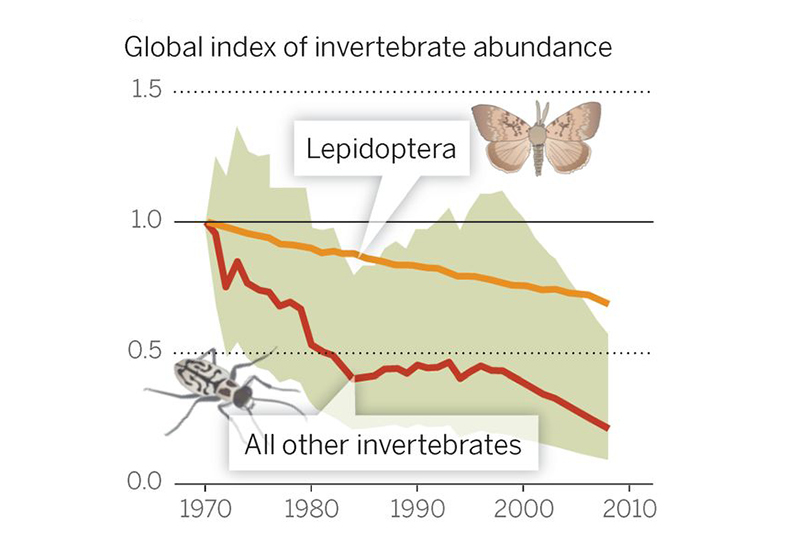
According to global monitoring data for 452 species, there has been a 45 percent decline in invertebrate populations over the past 40 years. DIRZO, SCIENCE (2014) – click to enlarge
As large and impressive as elephants are, and as much as we puny human’s like to associate ourselves with bigger things, that CO2 as a climate change elephant/element and its big effects upon the world’s climate is not the most pressing problem. Climate change impact is made tiny by the real crisis of CO2 driven biological change and its direct impacts on life on this planet.
The biggest impacts our high and rising CO2 is having is on the countless legions of the tiniest inhabitants, the insects, and their tiny ilk. Trillions upon trillions of tiny feet and wings are being stamped out on land and in the oceans.
If one imagines that the plight of the insects is global warming you will be following the trumpeting elephants into the politically charged world of climate politics and not learning the real story. Global warming’s impact on insects is, so far, not so much as a tick on an elephant’s thick skin in terms of the explanation for global insect demise. CO2 has far more immediate and dire direct biological effects on insects, it is folly to imagine the secondary effect of CO2 induced global warming is the most urgent and immediate problem here on spaceship earth.
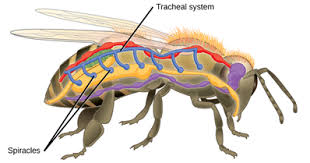
Insect spiracles take air from the outside and make it available to cells throughout and inside the tiny insect body…
CO2 is more intimately and immediately involved with insect biology than it is in the bigger life forms like elephants and people.
What the tiny are experiencing, as are we, is a 44% increase in CO2 over the past century. One effect of this rapidly changing high and rising CO2 is in how it changes insect breathing patterns that are far more delicate than our robust mammalian respiration. The ity bity bugs are tiny and hence the distance from the air to any cell in their bodies is very short, insects don’t have lungs they have spiracles, tunnels from their surface into their interior. The spiracles make the distance air is from each cell even shorter. Hence insects ‘breathe’ almost at the cellular level and as such their breath is incredibly delicately balanced with the CO2 and Oxygen in the air.
Oxygen is the deadliest of all insecticides
Insects evolved to regulate the amount of breathing they do, not to bring the most oxygen possible into their tiny bodies, but rather to greatly regulate and reduce the oxygen entering their bodies. Oxygen is the deadliest of all poisons at the cellular level. That deadly nature of oxygen is why we humans are so well versed in our anti-oxidants, and the need to keep our oxidative stress under control. Insect biology monitors CO2 in their cells and in the air as CO2 is a waste product that like us they must do gas exchange with the air to get rid of.
Insecticides kill via oxidative stress
In the literature of insecticides, it is well reported “that stimulation of free radical production, induction of lipid peroxidation, and disturbance of the total antioxidant capability of the body are the mechanisms of toxicity in most pesticides, including organophosphates, bipyridyl herbicides and organochlorines.” Our most potent pesticides don’t hold a candle to natures oxidative stress due to oxygen itself, in fact, they are designed to merely make oxidative stress happen more readily. Our sudden flooding of the world with high CO2 levels is tragically doing the same.

CO2 has an insidious effect that is missed by many, it’s deadliest effect is not on adult organisms but rather on the larval stages of the vulnerable. In larval shellfish, they are prevented from growing their first microscopic shell. Insect larvae simply fail to thrive due to oxidative stress. – Click to read more
The difference between the CO2 in insect bodies and the CO2 in the air is what the bugs have to keep track of and have to balance. They breathe as little as possible to keep their internal CO2 in their safe zone but more importantly to limit the amount of deadly Oxygen they take in (Journal Nature). They evolve to adapt to changing CO2 in the air, that’s phylogeny, but evolution is a very slow process, taking thousands to millions of years to make changes.
Insect ontogeny, their individual ability to adapt, such as to seek shade when the sun is too hot, or to hibernate when it is too cold, allows them to deal with most environmental change. But something changed dramatically in their world over the course of a hundred years or so. We, humans, came along and suddenly discovered how we could use fossil fuels. We’ve burned enough fossil fuel in the past century to increase the amount of CO2 in our collective human and insect air by 44%. To match that level of atmospheric CO2 insect ontogeny, adaptation, makes them breathe more to equilibrate their internal CO2 with the air, that’s simple chemistry of gas exchange dynamics.
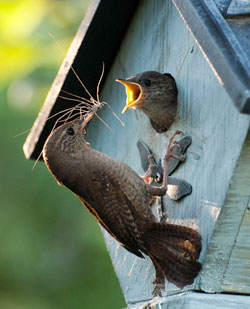
Insects are the lynchpins of many ecosystems. Around 60% of birds rely on them for food. 80% of wild plants depend on them for pollination. If they disappear, ecosystems everywhere will collapse, insects are in trouble, we’re all in trouble. In the last half of the insect study time frame a German birds have seen a 15-20% decline.
The Tipping Point Crossed
As a result of our brief century long CO2 sins of emission insects are breathing in way too much air and its deadly oxygen. The tipping point was clearly crossed about 30 years ago. The result is insects are fast disappearing due to the lethal dose of yesterday’s CO2 we humans have put into the air. Insect hyperventilation is a response dictated by CO2 where tiny elevated levels trigger the deadly relaxation effect in the muscles that control their spiracles leaving them wide open to poisonous oxygen.
IT IS NOT OUR PESTICIDES THAT IS ERADICATING THE INSECTS WE ARE THE PESTICIDE WITH OUR PLANES, TRAINS, AND AUTOMOBILES and perhaps heavy breathing in endless debates about what to do about ‘climate change’ while we do next to nothing.
To put the crisis in the air that the insects are seeing in human terms
The CO2 in the air is what keeps insects safe from deadly oxygen (or it used to), this is just about the opposite of our human need for oxygen. But how does 44% more CO2 in the air relate to our more familiar oxygen? That’s easy numerology, as we humans have a living experiment in the oxygen we live with. The higher the elevation the less oxygen we have access to. We humans don’t inhabit, in any numbers, elevations above 10,000 feet, there simply isn’t enough oxygen for us. Yes, yes, a few of us are able to live at slightly higher elevations or go up there for short climbing trips. Only 6% of the human race lives above 5,000 feet, a fraction of 1% of us live above 10,000 feet.
Coincident with the progression of the fossil fuel age the Oxygen content of the air at 5,000 feet is down by 20%, at 10,000 feet where few humans survive the oxygen is down by 44%! That is the same 44% number is seen on the ‘flip side’ as the CO2 increase level that makes life nigh unto impossible for bugs. Insects at low elevations are living, or more clearly stated dying, at the present day 44% elevated CO2 in their air that regulates their respiration. We humans as a species would be in equally bad shape if suddenly we only had the oxygen needed to support less than 1% of our numbers. That data on lack of humans at high elevation is a lesson to consider in this context.
Yesterday’s CO2, all of our excessive CO2 from our fossil fool age is already a lethal dose already administered to our planets living environment. But what can we do, do we have an antidote.
Surely we must work to not send another lethal dose of CO2 into the world’s air. But the elephantine trumpeting debates over climate change are not leading to the immediate solutions we and our tiny friends must have in time to save all. What to do debates that are 99% focused on the certainty that without dramatic action humanity will be responsible for chasing the first lethal dose of with a second lethal dose is missing the real elephant in the room. What good is an argument over how fast we administer a second lethal dose given we have already administered a first lethal dose?
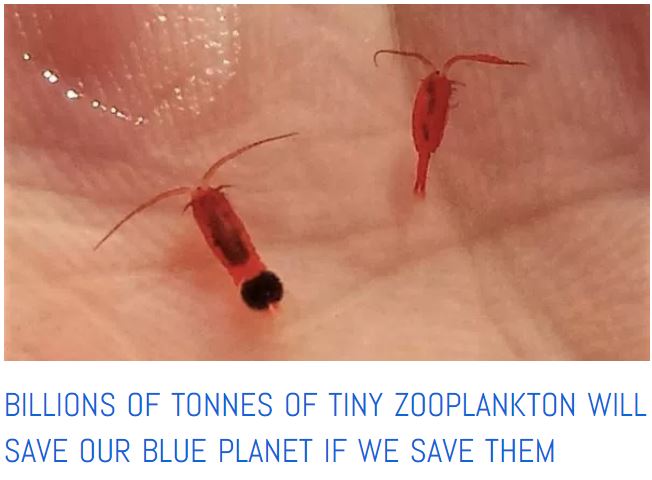
We don’t have to go it alone to save our planet from our deadly CO2. We have trillions of tiny allies. Click to read more
That yesterday’s trillion tonne dose of our CO2 already in the air, that is demonstrably responsible for the killing off of up to 75% of the insects on this planet, is nothing short of apocalyptic. Our first and foremost task must be to administer the antidote to that first lethal dose before it is too late to do so.
Is it already too late for the insects of planet Earth…
This is a close call. Insect numbers have declined by 75% in just 30 years and ocean plankton are down by 50%. Are you willing to continue the experiment of watching the deadly effects of our yesterday’s deadly overdose while some few dogmatists argue that the cure might have side effects? The observable deadly effects in the here and now are surely, as far as the insect kingdom and plankton kingdoms are concerned, an absolute real and present danger. They may have only 10 years left on this blue planet of ours.
The antidote needs energy, lots and lots of energy.
Since it took using the energy of all the fossil fuels burned in human history to send that first, yesterday’s, lethal dose of that trillion tonnes of CO2 into the world’s air we can take a lesson from scientists like Arrhenius. They follow a simple chemical law that being the 2nd Law of Thermodynamics. It states that it takes as much energy to run a reaction in reverse as it does forward.
The vital antidote that will save the insects and countless other life as we know it on this blue planet is to remove and repurpose our trillion tonne lethal overdose of CO2 from our air. That’s a mighty task and it will take as much energy as humanity has consumed in the past century. And the energy we use better be clean energy as we can’t just pour more new deadly CO2 into the air scrubbing the old deadly CO2 out of the air.

Here’s a place to start reading about the antidote to yesterday’s CO2 that just might save the insects. Click to read more
The ONLY source of such a massive amount of clean, green energy, to be the antidote to our yesterday’s lethal dose of CO2 is sunlight powered photosynthesis. The plant life on this planet can rise to the common cause and save the world from our CO2 by repurposing our trillion tonnes of CO2 into new life. But they can’t do it overnight they will need decades of growth to do so. And clearly, they cannot do it in time to save the insects and us without our help.
Everywhere on this blog, you will find information on just how potent, powerful, and at the ready, the world of ocean plant life is to begin this vital job, all they need from us is the tiniest amounts of vital dust.
It’s not too late to administer the antidote for our deadly sins of emission, join me!
All that is required for the triumph of evil is for good men to do nothing! – Edmund Burke









